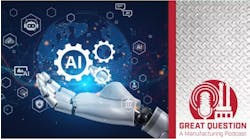Safety has always been a top concern for oil-and-gas suppliers. Because pipelines must operate 24 hours a
day and 365 days a year, safety, high availability and reliability are key requirements for smooth operations and, ultimately, profitability.
New safety and security threats have challenged the traditional approaches oil-and-gas suppliers have taken to protect their people, production and profits. The Industrial Internet of Things (IIoT) has transformed process automation in the industry by providing a backbone of connected assets, cloud and analytics technologies that simplify and enhance upstream, midstream and downstream applications. However, if not implemented correctly, IIoT can endanger the safety of pump and refinery operators, as well as the integrity of the machines themselves.
Of course, focusing exclusively on risks does not provide a 360-degree view of the opportunities the connected landscape provides to actually enhance safety and increase profitability.
IIoT unlocks the potential of profitable safety. If that seems like an oxymoron, it’s understandable, because efforts to ensure refinery safety have been costly and often ineffective, especially considering the volatile, high-risk nature of oil-and-gas pumping environments. Today, with persistent, automated safety-integrity monitoring and safety-systems validation, as well as high-speed data capture to support pump analytics and diagnostics, safety becomes something more robust and valuable for oil-and-gas pump operators. New technologies enable new visibility for pump operators into the workings of systems and their entire operation, so that it’s more straightforward to identify potential vulnerabilities to degradation or impairment by disruptions in their internal or external environments.
Consider the impact of advances in augmented reality (AR) and virtual reality (VR) in the pumping process. Newly empowered with the ability to aggregate big data and simulate real-life situations, operators can leverage immersive VR technologies to optimize operations, train operators and design processes. Part of this includes maximizing a safe work environment by mimicking many potential hazards while reducing the costs of business interruption. Simulation software enables training for all kinds of applications and can be delivered in a 3-D, photorealistic and interactive environment.
Interested in network solutions? Network with experts at the 2018 Smart Industry Conference. Click here to learn more.
The ultimate goal of any oil-and-gas operation is making money. Driving operational-profitability improvements starts with optimizing the performance of each pump so it performs in the safest, most secure, environmentally sustainable, reliable and efficient manner possible. With stronger computing power and advanced technology, it is possible to implement real-time control at the asset level, while incorporating big data and predictive analytics to measure how every pump is contributing to operational profitability. Empowered with the ability to control business variables, including safety in real time, pump operators are now able to make process improvements when the ROI will be highest.
For example, pump operators can leverage IIoT to determine whether it’s a better decision to immediately discontinue a faulty pump and lose money in the near-term or replace it at a later date. Additionally, thanks to more connectivity and computing power, smarter, connected pumps can now control, monitor and secure themselves to become autonomous assets.
The days of safety and profitability being mutually exclusive in oil-and-gas pumping operations are coming to an end thanks to the connected technologies that have emerged and continue to grow in the industry. Leveraging IIoT to maximize safety boosts profitability, and suppliers would be wise to plan for both variables in a unified strategy.
Steve Elliott is senior director of offer marketing—Process Automation with Schneider Electric.


